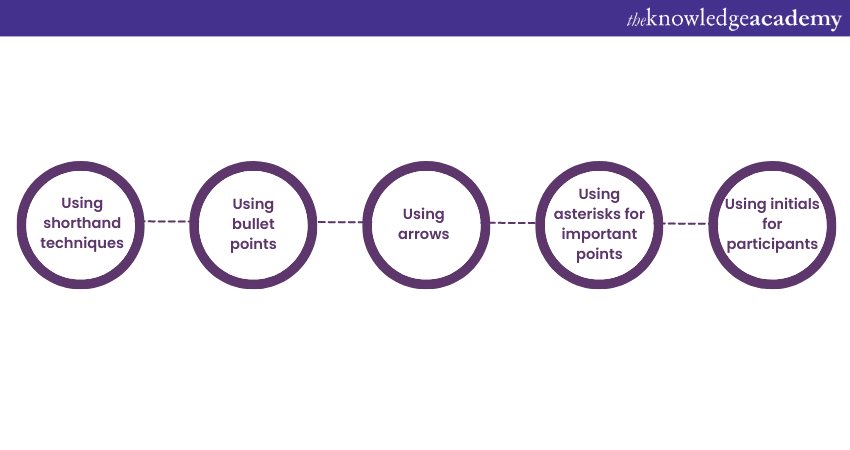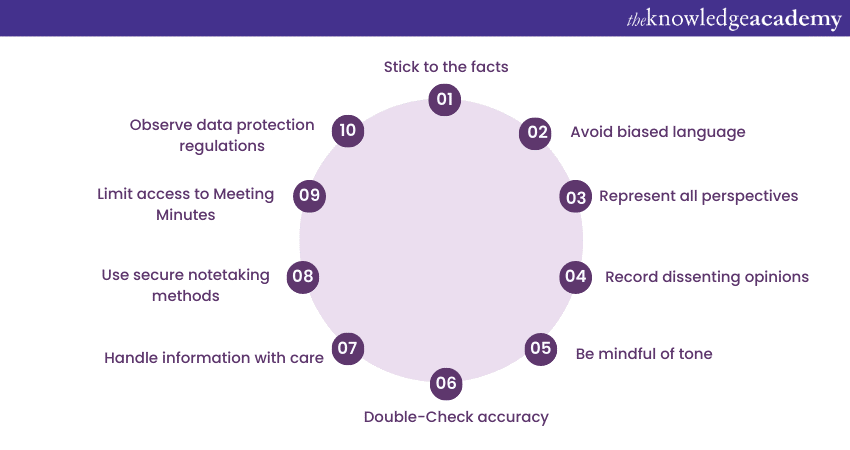We may not have the course you’re looking for. If you enquire or give us a call on +1800812339 and speak to our training experts, we may still be able to help with your training requirements.
We ensure quality, budget-alignment, and timely delivery by our expert instructors.

Effective communication is important in any professional setting, and accurate record-keeping of discussions is vital in ensuring clarity and accountability. Therefore, learning Minute-Taking Techniques is crucial to driving more comprehensive and insightful Meeting Minutes.
Learning the best Minute Taking Techniques and Tips can empower you to capture essential information during meetings, summarise discussions, and produce well-structured Meeting Minutes. So, if you don’t know how these techniques can make your Meeting Minutes more valuable, it’s time to learn them now.
Further, read this blog to learn about the top Minute Taking Techniques. Also, gain important Minute Taking Tips for effectively recording the meeting details.
Table of Contents
1) Understanding the importance of Meeting Minutes
2) What are various Minute Taking Techniques?
a) Prepare for the meeting
b) Active listening
c) Effective notetaking
d) Structure and organisation
e) Selective summarisation
f) Active participation
g) Use clear language
h) Post-meeting verification
3) Tips for effective Minute Taking
4) Conclusion
Understanding the importance of Meeting Minutes
Noting Meeting Minutes are a fundamental aspect of effective communication and organisational efficiency. They are an official record of what transpired during a meeting, capturing critical discussions, decisions, and action items.
Therefore, understanding their importance is essential for all professionals involved in meetings. Here are key reasons why Meeting Minutes hold significant value:
a) Documentation and reference: Meeting Minutes provide comprehensive and reliable documentation of discussions, decisions, and action items. They serve as a point of reference for participants, ensuring everyone is on the same page.
b) Legal and compliance requirements: They can serve as evidence in legal disputes, making it crucial to record and maintain minutes accurately. Organisations can ensure compliance with legal and regulatory obligations by adhering to proper Minute Taking Techniques.
c) Accountability and transparency: These establish a clear record of who said what, who made decisions, and who is responsible for specific tasks. This helps prevent misunderstandings, disputes, and confusion, fostering a culture of transparency and accountability.
d) Effective decision-making: Noting Meeting Minutes allow participants to review discussions, consider various perspectives, and evaluate the reasoning behind decisions. Organisations can make informed decisions and track progress over time by referring to well-documented Meeting Minutes.
e) Historical documentation: They also serve as a historical record of an organisation's activities and decision-making processes. These provide insights into past discussions, strategies, and outcomes, which can be invaluable for future reference, audits, or analysis.
f) Communication and collaboration: Noting Minutes of Meeting ensures that participants understand the meeting’s outcomes and the tasks assigned to individuals. Minutes can be distributed to absentees or shared with stakeholders to keep them informed and involved.

What are various Minute Taking Techniques?
Minute Taking is a valuable skill that requires a combination of active listening, efficient notetaking, and effective organisation. Mastering How to Take Minutes in a Meeting various tips and techniques can greatly enhance your ability to capture essential information accurately and produce comprehensive Meeting Minutes. So, let’s explore each technique in detail:
1) Prepare for the meeting
Effective preparation is key to successful Minute Taking. So, you should familiarise yourself with the meeting agenda beforehand. Understand the purpose of the meeting, the topics to be discussed, and the expected outcomes. This will help you anticipate the meeting flow and prepare for notetaking accordingly.
Further, collect any relevant reference materials or documents related to the meeting topics. This may include previous Meeting Minutes, reports, presentations, or supporting documents. Having these materials on hand will enable you to refer to them during the meeting and ensure accuracy in your minutes.
2) Active listening
Actively listening during a meeting is crucial for successfully noting the minutes. All you need to do is maintain focus and concentration. Paying close attention to the discussions, decisions, and action items can help you capture the key points. This also helps ensure your Meeting Minutes are accurate and comprehensive.
3) Effective notetaking
Effective notetaking means you must perform the following activities:

Developing an efficient notetaking practice is essential for capturing information quickly and accurately. Consider using shorthand techniques, such as abbreviations, symbols, and bullet points, to summarise discussions and decisions.
Further, you can create a personalised system that works best for you, using arrows to denote action items, asterisks for important points, and participant initials. This technique will enable you to take notes more efficiently and improve the quality of your meeting.
4) Structure and organisation
Creating well-structured and organised Meeting Minutes is essential for clarity and ease of reference. Follow the meeting agenda as a guide and use headings and subheadings to categorise different topics and discussions. This approach allows readers to navigate the minutes easily and locate specific information quickly. Additionally, a clear and logical structure also helps maintain the flow of information and ensures that all relevant points are captured.
5) Selective summarisation
While capturing key information is important, it’s equally crucial to avoid transcribing every word spoken during a meeting. Practice selective summarisation by focusing on the main ideas, decisions, and action items.
Furthermore, summarise discussions concisely, highlighting the key points without hindering accuracy. This technique ensures that your Meeting Minutes are concise, readable, and capture the essence of the meeting.
Additionally, organise the minutes based on the meeting agenda. Use headings and subheadings to separate different topics and discussions. This creates a logical flow and makes it easier for readers to find relevant information.
6) Use clear language
Use clear and simple language in your Meeting Minutes. It’s better to avoid jargon and technical terms, difficult for readers to understand. Aim for brevity while ensuring the information is conveyed accurately.
Further, maintain a consistent format throughout the minutes. Use bullet points or numbered lists for action items, decisions, and important points. This enhances readability and makes it easier for readers to skim through the document.
7) Active participation
Engaging in discussions, asking clarifying questions, and seeking participant input can help you better understand the topics. This also ensures that your minutes reflect the discussions accurately. Active participation lets you identify and prioritise important information, resulting in more valuable and focused Meeting Minutes.
8) Post-meeting verification
After the meeting, take the time to verify your Meeting Minutes for accuracy. Ensure to do the following:
a) Review your notes
b) Cross-check any unclear points
c) Seek clarification from participants if necessary
Performing these steps ensures that your Meeting Minutes are a reliable representation of the discussions and decisions made during the meeting.
Enhance your skills in PA and Secretarial roles with our comprehensive PA and Secretarial Training.
Tips for effective Minute Taking
Mastering the art of Minute Taking requires a combination of skills, techniques, and attention to detail. To enhance your abilities to note minutes and produce effective Meeting Minutes, consider the following tips:

a) Stick to the facts: Focus on capturing information rather than noting personal interpretations or opinions. Record what was said and decided during the meeting without adding subjective commentary. Your summary should reflect the objective reality of the meeting, allowing readers to form their own judgments based on the facts presented.
b) Avoid biased language: Use neutral and unbiased language in your Meeting Minutes. Steer clear of language that may convey personal bias or subjective viewpoints. Be mindful of how you phrase statements, ensuring that they are objective and free from any personal judgments or preferences.
c) Represent all perspectives: Ensure that all perspectives and viewpoints expressed during the meeting are accurately captured in your minutes. Using a Minute Taking Template can help structure your notes effectively, ensuring that different opinions receive equal weight without favoring one viewpoint over another. This balanced approach fosters fairness and impartiality in your Meeting Minutes.
d) Record dissenting opinions: If dissenting opinions or disagreements are expressed during the meeting, include them in your minutes. It is essential to reflect divergent views and differing perspectives accurately. By acknowledging and documenting dissent, you maintain transparency and demonstrate a commitment to impartiality.
Master the art of note-taking with the Effective Minute-Taking PDF. Get it now!
e) Be mindful of tone: Pay attention to the tone of your summary. Use a professional and neutral tone throughout the document. Also, avoid language that may appear aggressive or dismissive. Strive to present the discussions and decisions objectively, reflecting the overall tone and atmosphere of the meeting.
f) Double-Check accuracy: Take the time to double-check the accuracy of your Meeting Minutes. It includes reviewing and comparing your notes with any available recordings or supporting materials. Further, ensure that the information you captured aligns with the statements made during the meeting.
g) Handle information with care: Ensure you handle confidential or sensitive information appropriately, both during the meeting and when preparing the Meeting Minutes. Further, exercise discretion and avoid discussing sensitive details outside the designated channels.
h) Use secure notetaking methods: If you opt for digital notetaking, use password-protected devices and encrypted file storage to safeguard the information. If you prefer handwritten notes, keep them in a secure location and destroy them once the Meeting Minutes have been transcribed.
i) Limit access to Meeting Minutes: Share the minutes on a need-to-know basis, ensuring that only those directly involved or relevant to the meeting have access. Consider using secure file-sharing methods or password-protected platforms for distributing the minutes.
j) Observe data protection regulations: Familiarise yourself with relevant regulations like the General Data Protection Regulation (GDPR). Also, ensure that you comply with these regulations when handling sensitive information during and in subsequent meetings.
Learn the essential office and administrative skills with our Office Skills Masterclass.
Conclusion
Mastering Minute Taking Techniques and Tips is essential for effective communication and meeting record-keeping. By understanding the importance of Minute taking, preparing adequately and structuring the minutes logically, you can ensure accurate and comprehensive documentation.
Take the next step towards becoming a proficient Minute Taker with our Minute Taking Training.
Frequently Asked Questions
Upcoming Business Skills Resources Batches & Dates
Date
 Company Secretary Training Course
Company Secretary Training Course
Fri 21st Mar 2025
Fri 2nd May 2025
Fri 27th Jun 2025
Fri 29th Aug 2025
Fri 3rd Oct 2025
Fri 5th Dec 2025






 Top Rated Course
Top Rated Course


 If you wish to make any changes to your course, please
If you wish to make any changes to your course, please


